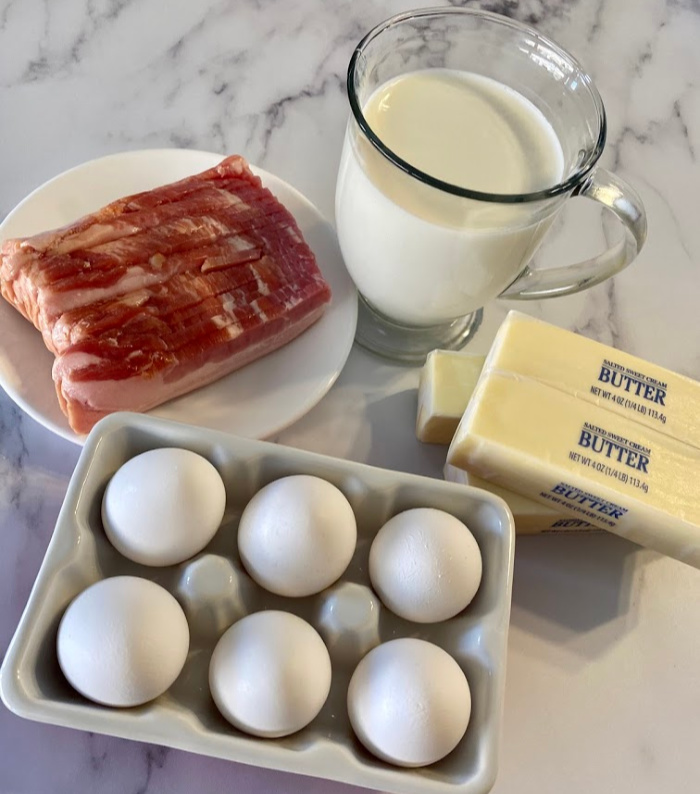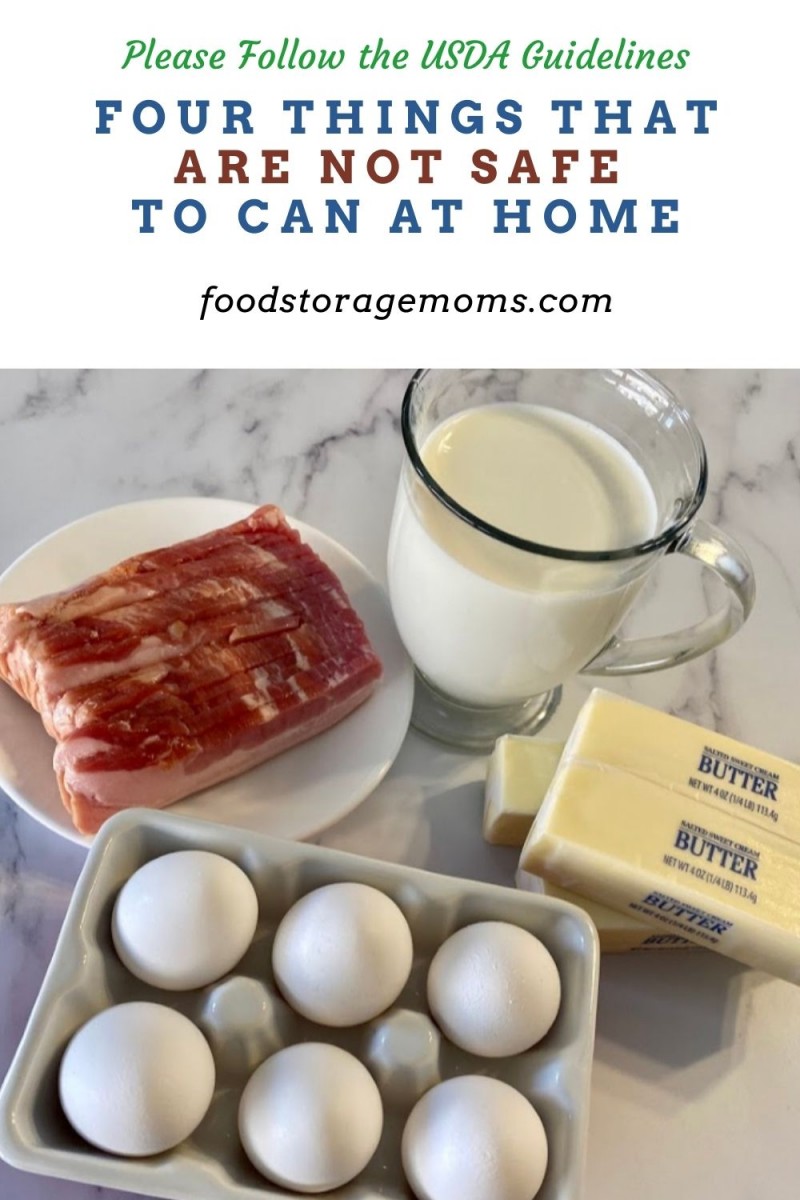
There are four things that are not safe to can at home. Period. Any readers who have been following my posts over the years know that I’m consistently promoting the idea to garden what you’ll harvest and eat, and try to can as many items as possible so you’ll know what the product contains, and hopefully you’ll eat healthier.
Lately, I have been concerned with articles on Facebook or blogs with posts stating you can preserve certain foods at home that I knew were not safe to can. Then I started getting emails and Facebook PMs asking me if this post or that post was accurate.
In my gut, I knew some of the foods weren’t safe to can. So I went to the experts to confirm my thoughts. I am not a newbie to canning. I have been safely canning my foods per Utah State Extension service guidelines for over 50 years. Please note, I don’t work for the USDA and I’m not paid by them to write about this issue.
I also have my Master Preserver Canning Certificate via the Utah State University Extension Service who sponsored and taught the USDA training courses. This is an updated article where I added milk to my list. I’m hearing that a lot of people are canning milk and cream. These are unsafe to can at home because of the fat content they have.
I believe more and more people are water bath canning and pressure canning their own food. I applaud you, but please buy the two canning books I have suggested below so you can get the best information available regarding safe canning techniques. Let’s be safe and keep our families healthy.
Now, you might say, “I learned how to “can” those items from my friend (or whoever), and my jars look great.” They may even taste okay. But here’s the clincher, you don’t know what bacteria is lurking inside those jars. Please, please, please don’t risk the health of your family by canning these higher-risk food items.
Carolyn (my instructor) mentioned the reason certain foods are not listed on your local state canning extension service lists is that they have not been proven safe to preserve via our home canning process. Please order a USDA Canning Guide or the Ball Canning Guide to learn the safest techniques.
Four Things That Are Not Safe To Can At Home

Four Foods Not Safe To Can At Home:

1. Never Can Eggs
I want to bring this issue to everyone’s attention because eggs are not safe to can at home. Bacteria will grow and you may not even see it in the jars when eggs are canned at home. Now, I am not talking about pickled eggs, which are safe for storage in the refrigerator for a short period of time only.
Please don’t water bath or pressure can eggs. Call your local extension service if you still think you can “can” your own eggs. If the food item you have a question about canning yourself isn’t listed on your local extension service it is more than likely unsafe to process at home.
Yes, you can freeze eggs, but personally, I don’t want to fill my freezer with eggs. The texture will not be the same with frozen eggs if you try eating them thawed right out of the freezer, but they would work for baking. I get nervous about the electricity going out. I can only imagine trying to get rid of those thawed eggs in a power outage.
I love reading about people having chickens and gathering eggs from their chicken coops. I have heard good stories from people who are learning to raise chickens who have the land and families working together as a team. I have also heard they have excess eggs and want to know what to do with all those eggs.
Let’s get real here, please save money and buy some professionally processed eggs in #10 cans for long-term storage needs. Another option is to purchase them in properly sealed packages from a reputable company. I only buy Ova Easy Eggs for my long-term storage. They are real eggs, you can scramble them, make a frittata, quiche or bake with them.
I have a few #10 cans of powdered eggs, but I must say, they don’t taste like eggs when cooked in a frying pan, even with butter. They will be fine for baking muffins, cakes, pancakes, or bread. These are the only ones I like to buy because they taste just like fresh eggs out of a carton: OvaEasy Powdered Whole Eggs – Case (12 x 4.5 oz Bags)
2. Never Can Bacon
There is too much fat in bacon to make it safe for canning at home. I’m not a scientist or microbiologist to be able to explain correctly the significance of the bacteria that grows in bacon if you try canning it at home. I realize some people have canned bacon for years and swear by its safety.
Here again, we don’t know what’s lurking in our home-canned bacon. I highly recommend you don’t can bacon at home. Here’s the deal, I love bacon. Doesn’t everything taste better with bacon in it? My husband and I have been eating BLTs for years with the tomatoes out of our garden.
The only bacon inventory on my food storage shelves are four cans of professionally processed cooked Yoder’s Bacon. They will be used for a treat if we are without power for weeks. It’s way too expensive per pound to store much more.
I bought six cans of canned bacon from Yoder’s. I taught a class with one can and did a post with the other can. I compared the price of precooked bacon from Costco and one can of Yoder’s: Yoder’s Bacon & Ova Easy Eggs by Food Storage Moms.
Yes, I freeze a few packages of bacon when it goes on sale. I thaw it in the refrigerator and bake it in the oven the next day. I line a cookie sheet with foil and spread the bacon out in single layers as well as I can. I bake the bacon at 400 degrees for 45-60 minutes, depending on how crispy it gets in that time period.
I love that my stovetop stays clean by baking the bacon in the oven. I learned this from my daughter and her husband. It’s so much easier. Please note: I buy very thick bacon from a meat butcher or Costco, so if your bacon is thinly sliced, cut the cooking time in half. Yoder’s bacon: Yoders Canned Fully Cooked Bacon
3. Never Can Butter
Next, let’s talk about butter. It isn’t safe to can at home either. Maybe you had a friend show you how to can it? Like bacon, butter has way too much fat in it to safely can it at home. Here again, we don’t know what bacteria may be growing in those jars.
I watch for butter to go on sale and fill my freezer with as many packages as my budget will allow. I also bought some powdered butter that tastes awful. I get the dry heaves just thinking about the smell of it. One website states their powdered butter “tastes like Land O’Lakes butter.” No, it doesn’t, I have tried them all. They are fine for baking because the other ingredients cover the flavor of their powdered product.
This is a statement I was given from the USU Extension Service on a sheet of paper listing food to NOT store:
“Home Canned Butter, especially unsalted butter, has NO protection from botulism. Salted home canned butter has no science-based process to can safely. Heating the jars does sterilize it, but it will NOT kill any botulism spores. When you remove the oxygen from the jar, it allows for the potential growth of botulism spores.”
I highly recommend this brand of canned butter for your food storage: Red Feather PURE CANNED BUTTER
4. Never Can Milk or Cream:
Here’s what the experts say about canning milk or cream, it is unsafe to preserve by water bath or pressure canning. The milk and cream have too much fat, just like the other food items in this post. This is what I found on the USDA website: “Caution: Do not add noodles or other pasta, rice, flour, cream, milk or other thickening agents to home-canned soups. If dried beans or peas are used, they must be fully rehydrated first.”
In the classes I took to pass my Master Preserver Canning Certificate, we were reminded of these four products I have listed above that they are unsafe to can because we cannot get our pressure canner up to the temperature required to kill off the bacteria. This is why I buy these products from commercial companies that have the necessary equipment to can them safely.
Comments from Readers:
Lauralee H: Explains how butter was stored in pioneer days. The pioneers only made small batches of butter at a time from milking their cow. Then they stored it at room temperature in a butter bell. A ceramic type of dish where they spooned the butter into the top bell part and over the butter poured a small amount of boiled salted water that was cooled over the butter.
Then a plate-type bottom was placed on it, and it was turned over quickly and sat down on the counter. That way the salted water was on the bottom of the butter sealing out the air. Each time they needed the butter they poured the water off and used the butter.
Most of them did salt their butter back then when churning it. They tried not to make too much butter at a time, only what they could use up in maybe three days. If they made big batches they were going to do baking that would use it up. I think you can still purchase butter bells.
Shelley: The National Center for Home Food Preservation is the go-to resource for safe, approved methods and recipes. If I ever have a question this is where I go. I am also a Master Food Preserver through Washington State University and I also rely on our Extension Services to provide information. Please don’t trust the online resources you see as safe. Research first!
Another Linda telling me what her mom did years ago: Hello, great post. My mom was born in 1910. She told me stories of how things were done in Ky for generations. They had cold dairies (called various things) but what it came down to was watch where the river level was at the highest point in the year and go a few feet above this.
You dig out the riverbank, shore it up, just like they do in the mines, caves, etc. Milk, eggs, butter was stored. mom said it was very cold even in the summer. Winter temps allowed longer storage thus greater amounts were stored. For pitted fruits, a fruit cellar dug into a mountain or wood building covered to be a small hill, etc.
JoEllen: Actually you might have included anything “dairy” as something unsafe to water bath or pressure can as well. There’s a crowd out there who advocate water bath canning of extra milk. Hopefully, they will survive their ICU stay.
Please be careful when canning ANY foods at home, but these four should never be canned at home. Here’s to safe canning.May God bless this world. Linda
Utah State Extension Service: Utah State Extension Service.
My favorite things:
Ball Mason Wide Mouth Quart Jars with Lids and Bands, Set of 12
All American 921 21 Quart Pressure Cooker Canner
Norpro Canning Essentials Boxed Set, 6 Piece Set
Ball Enamel Water Bath Canner, Including Chrome-Plated Rack and 4-Piece Utensil Set
Ball FreshTech Electric Water Bath Canner, Silver
The post Four Things That Are Not Safe To Can At Home appeared first on Food Storage Moms.
